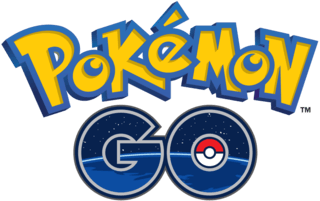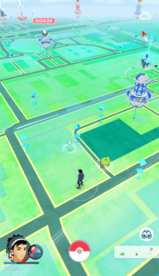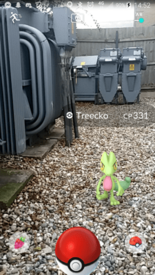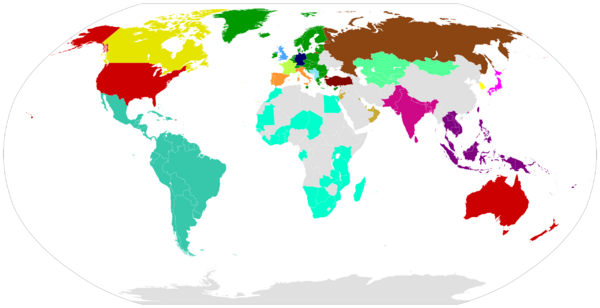Pokémon Go facts for kids
Quick facts for kids Pokémon Go |
|
|---|---|

Game logo
|
|
| Developer(s) | Niantic |
| Publisher(s) | Niantic |
| Director(s) | Tatsuo Nomura |
| Artist(s) | Dennis Hwang Yusuke Kozaki Mieke Hutchins |
| Composer(s) | Junichi Masuda |
| Series | Pokémon |
| Engine | Unity |
| Platform(s) | iOS, Android |
| Release date(s) |
July 6, 2016
|
| Genre(s) | Augmented reality, location-based game |
Pokémon Go (stylized as Pokémon GO) is a 2016 augmented reality (AR) mobile game, part of the Pokémon franchise, developed and published by Niantic in collaboration with Nintendo and The Pokémon Company for iOS and Android devices. It uses mobile devices with GPS to locate, capture, train, and battle virtual Pokémon, which appear as if they are in the player's real-world location. The game is free-to-play; it uses a freemium business model combined with local advertising and supports in-app purchases for additional in-game items. The game launched with around 150 species of Pokémon, which had increased to around 700 by 2021.
Pokémon Go was released to mixed reviews; critics praised the concept but criticized technical problems. It was one of the most used and profitable mobile apps in 2016, having been downloaded more than 500 million times worldwide by the end of the year. It is credited with popularizing location-based and AR technology, promoting physical activity, and helping local businesses grow due to escalated foot traffic. However, it attracted controversy for contributing to accidents and creating public nuisances. Various governments expressed concerns about security, and some countries regulate its use. The game had over 147 million monthly active users by May 2018, over a billion global downloads by early 2019, and grossed more than $6 billion in revenue by 2020.
Contents
Gameplay
Augmented reality gaming
After establishing a game account, players create and customize their own avatars. Once created, an avatar is displayed on a map based on the player's geographical location. Features on the map include 'PokéStops' and 'Pokémon Gyms'. These PokéStops can be equipped with items called 'Lure Modules', which attract additional wild, and occasionally rare, Pokémon. Gyms serve as battle locations for team-based king of the hill matches. PokéStops and Gyms are typically located at places of interest. These locations were initially re-purposed portals from Ingress, Niantic's previous augmented reality (AR) game. This has led to PokéStops and Pokémon Gyms being placed at dangerous or inconvenient locations, such as a now-deleted Gym at the Korean Demilitarized Zone and Bagram Airforce Base, which was abandoned by U.S. forces in July 2021. Since 2019, these locations also include submissions from Go players which are largely reviewed by other players.
As players move within their real world surroundings, their avatars move within the game's map. Different Pokémon species reside in different areas of the world; for example, Water-type Pokémon are generally found near water. When a player encounters a Pokémon, it may be viewed either in AR mode or with a live rendered, generic background. AR mode uses the camera and gyroscope on the player's mobile device to display an image of a Pokémon as though it were in the real world. Players can take screenshots of the Pokémon they encounter either with or without the AR mode activated.
Although the game is free to play, it supports in-app purchases, where players can purchase additional Poké Balls and other in-game items. These items include Incense, which attracts Pokémon to the player as they move for sixty minutes, Lure Modules, which players use at PokéStops to attract Pokémon to their current location near the PokeStop, and Lucky Eggs, which double experience points gained for a thirty-minute period from use. All Pokémon are displayed with a Combat Power, which is a rough measure of how powerful that Pokémon is in battle. Generally, as players level up, they catch Pokémon with higher CP and Pokémon are somewhat harder to catch. The player can check how strong their Pokémon are by the "Appraisal" system.
Avatar Customization
Players can customize their avatar's appearance with clothing options that differ in availability according to season, player level, and game sponsors. Clothing includes: hats, accessories, tops, bottoms, socks, footwear and bags. Most clothing aligns with either the look of a specific Pokémon, a specific team and/or Pokémon region. Many pieces of clothing are free, but pieces can also be purchased using coins, earned during select events, awarded as the player levels up, or received as a prize for special research completion.
Another way for a player to customize their avatar is with a pose. Poses, like clothing, are free, purchased, or awarded. Certain poses are event based and can only be earned during the event they are attached to. Once the event is over, there is no guarantee that the pose will be available in-game again.
In April 2024, Pokémon GO was updated to allow greater customization of player avatars. Customization now includes a limited number of different hair styles, the ability to adjust the weight of the avatar, and expanded options for skin color. This update was met with mass backlash from the playerbase, as the new avatars were perceived to be of inferior graphical quality in comparison to the outgoing models, and because the updated models interfered with some pre-update cosmetic items, of which many had been purchased by players.
Pokémon collection
Unlike most other installments in the Pokémon series, players in Pokémon Go do not battle wild Pokémon to catch them. During an encounter with a wild Pokémon, a player may throw a Poké Ball at it by flicking it from the bottom of the screen up toward the Pokémon. If the Pokémon is caught, it will come under the ownership of the player. Factors in the success rate of catching a Pokémon include the Pokémon's catch rate, the timing, the type of Poké Ball used, etc. After catching a wild Pokémon, the player is awarded two types of in-game currencies: Candies and Stardust. The Candies awarded by a successful catch depend on what evolutionary chain a Pokémon belongs to. A player can use Stardust and Candies to raise a Pokémon's level and hence "Combat Power" (CP). However, only Candies are needed to evolve a Pokémon, except for certain Pokémon that might need special items. Each Pokémon evolution tree has its own type of Candy, which can only be used to evolve or level up. The maximum level a player can achieve was originally level 40, but expanded to 50 as of November 30, 2020. The player can also transfer the Pokémon back to the Pokémon Professor Willow to earn more Candies and create room for more Pokémon. Shiny Pokémon are available through multiple ways, mostly by chance. One popular goal of the game is to complete the entries in the Pokédex, a comprehensive Pokémon logbook, by catching and evolving them to collect every one in it.
In September 2016, Niantic introduced a "Buddy Pokémon" feature, which allows players to pick a Pokémon to appear alongside them on the profile screen, and receive in-game rewards and bonuses based on the chosen Pokémon. The feature was released later that month. Certain Pokémon have different distances that they need to be walked in order to receive candy. The more the player walks in real time, the more candy they can earn. During the same update, Niantic made it impossible for players with rooted or jailbroken devices to log into the game in an effort to reduce and prevent cheating.
On January 20, 2018, Pokémon Go held the first Community Day, a monthly event that increases the appearance rate of a specific Pokémon and offer an exclusive move to the final evolution of the featured Pokémon only if caught or evolved during the event window. Players also have a higher chance to catch the Shiny variant of the featured Pokémon. The first Community Day featured Pikachu, with the exclusive move Surf to Raichu.
Pokémon availabilities
The game is regularly updated with new Pokémon, and as of March 25, 2022, there are just over 730 Pokémon in the game (not including regional varieties) out of a total 1008.
Regional Pokémon are often released together, such as Hoenn region Pokémon released in December 2017, Alolan variants in May 2018, Sinnoh region Pokémon(along with the Sinnoh Stone item used to evolve them) released in October 2018, Unova region Pokémon (and the Unova Stone) in September 2019, Kalos region Pokémon in December 2020, and again more Alola region Pokémon in March 2022.
Mythical and legendary Pokémon are often released individually (or in pairs/trios) in special events or quests. The first Legendary Pokémon released was Groudon, in December 2017. The Mythical Pokémon Meltan and its evolved form, Melmetal are so far the only Pokémon to have made their debut on Pokémon Go. Their release coincided with the release of Pokémon: Let's Go, Pikachu! and Let's Go, Eevee! on the Nintendo Switch, Pokémon Go introduced the new Mythical Pokémon Meltan originally as a teaser, later to be available to capture only in Pokémon Go via a "Mystery Box" item that could be obtained through transferring Pokémon from Pokémon Go to either Nintendo Switch Pokémon games, or by completing new Research Tasks.
In August 2020, Mega Evolution came to Pokémon Go with four Pokémon able to Mega Evolve into five forms.
Battle system
Gyms and Raids
Players earn experience points for various in-game activities. Players rise in level as they earn experience points (XP), with various features being progressively unlocked. Most-notably, at level five, the player can battle at a Pokémon Gym and join one of three color-coded teams (red for Team Valor, blue for Team Mystic, or yellow for Team Instinct), which act as factions battling for control of Gyms within the Pokémon Go world.
In June 2017, Niantic announced that the game mechanics of Gyms would be revamped for a more teamwork-oriented experience; Gyms were disabled on June 19, 2017, with the new Gyms being released with the next app update a few days later. As of the update, Gyms included a spinnable component to receive in-game items such as Potions and Poké Balls. Additionally, Gyms are capped at containing six Pokémon, each of which must be unique in that Gym. Coins are now earned based on the amount of time the defending Pokémon has been in a Gym, as opposed to a one-per-day gym defender bonus of 10 coins per current defending Pokémon. Legendary, Mythical and Buddy Pokémon cannot be placed in Gyms.
In July 2017, Raid Battles were introduced. Raid Battles consist of a group of players gathering to confront an over-leveled Pokémon located in a Gym. If the Pokémon is defeated, the players gain the chance to catch a regular version of it. Raid difficulties range from 1 to 5, with 1 being of the lowest difficulty, and 5 being the most difficult to defeat. Level 5 raids are exclusive to Legendary Pokémon. The first of these, Articuno and Lugia, were released on July 22, 2017, after the Go Fest, with Moltres and Zapdos following. From September to November, the 3 Legendary Beasts: Entei, Raikou and Suicune, were released shortly after, rotating regions every month. Following their departure, the Legendary Pokémon Ho-Oh appeared in Raid Battles from November 27, 2017, to December 12, 2017. In August 2020, level 3 Mega raids arrived with the introduction of Mega Evolution. At the same time, Level 2 and 4 raids were combined into Level 1 and 3 raids.
In May 2022, Raid Battle were updated to include the addition of Mega Legendary Pokémon, which were turned to 6 stars, the highest currently in the game. The only Pokémon included in these Raids were Mega Latios and Mega Latias.
In October 2022, a new form of raid battle called "Elite Raids" were introduced. Elite Raids differ to normal raids in a number of ways, most notably that they can only be battled in person, take 24 hours to start, and are extremely difficult, often requiring a large number of players to defeat the Pokémon.
In May 2023, another new form of raid battles were introduced called "Shadow Raids". Shadow Raids may only be battled in person and award the chance to catch a Shadow Pokémon upon defeat. During the battle, the Pokémon may become "enraged", increasing both attack and defence, but can be returned to normal using a "Purified Gem".
Trainer Battles
In December 2018, Niantic added player vs player Trainer Battles. In January 2020, Niantic rolled out an online battle format Go Battle League which allows players to fight other players worldwide. Unlike the Trainer Battles format introduced in 2018, Go Battle League does not require physical proximity, scanning QR code on each other's phone, knowing each other's friend code, or any other real-world interactions between players. Instead, participating players are automatically paired by the game server via some variant of the Elo rating system.
Team Go Rocket battles
In July 2019, Pokémon Go introduced Team GO Rocket battles. Team GO Rocket NPCs could be battled at PokéStops indicated with it twitching and being a dark color or in Team GO Rocket Balloons which follow the player on the map. After victory, the player has the opportunity to capture a "Shadow Pokémon" which are relatively low-leveled, angry-looking Pokémon. Shadow Pokémon have a higher attack stat but a lower defense stat than a normal Pokémon. After capture, the player can choose to purify the Shadow Pokémon. Purified Pokémon are higher-leveled than their Shadow counterparts, can learn an exclusive move when purified, and need fewer candies to evolve.
Development
Pre-release
The concept for the game was conceived in 2014 by Satoru Iwata of Nintendo and Tsunekazu Ishihara of The Pokémon Company as an April Fools' Day collaboration with Google, called the Google Maps: Pokémon Challenge. Ishihara was a fan of developer Niantic's previous transreality game, Ingress, and saw the game's concept as a perfect match for the Pokémon series. Niantic, a subsidiary of Google, used the crowdsourced data from Ingress to populate the locations for PokéStops and gyms within Pokémon Go, data from Google Maps to spawn specific Pokémon on certain terrain, and map display from OpenStreetMap since December 2017. The game's application logic uses the open source Kubernetes system - and due to the game's sheer scale of users, a number of bugs with the Kubernetes system was discovered and later fixed. Niantic was spun off from Google as an independent company in 2015 following the company reorganization into Alphabet Inc.
In 2015, Ishihara dedicated his speech at the game's announcement on September 10 to Iwata, who had died two months earlier. Tatsuo Nomura, who joined Niantic in 2015 after he developed the Google Maps Pokémon Challenge, acted as Director and Product Manager for the game. The game's soundtrack was written by longtime Pokémon series composer, Junichi Masuda, who also assisted with some of the game's design. Among the game's graphic designers was Dennis Hwang, who previously created the logo of Gmail while working for Google.
On March 4, 2016, Niantic announced a Japan-exclusive beta test would begin later that month, allowing players to assist in refining the game before its full release. The beta test was later expanded to other countries. On April 7, it was announced that the beta would expand to Australia and New Zealand. Then, on May 16, the signups for the field test were opened to the United States. The test came to an end on June 30.
Post-release
At the Comic-Con 2016, John Hanke, founder of Niantic, revealed the appearances of the three team leaders: Candela (Team Valor), Blanche (Team Mystic), and Spark (Team Instinct). Hanke conveyed that approximately 10% of the ideas for the game were implemented. Future updates, including the addition of trading, more Pokémon, implementation of Pokémon Centers at PokéStops, a patch for the "three step glitch", and easier training, were also confirmed. He also stated that Niantic would be continuing support for the game for "years to come". In an interview with TechCrunch in September 2016, Hanke hinted that player vs. player Pokémon battles would be released in a future update. In December 2016, coffeehouse chain Starbucks and telecommunications company Sprint collaborated with Nintendo to add PokéStops and gyms at certain locations of theirs throughout the United States. That same month, a companion app for Apple Watch devices was released, which allows users to receive notifications about nearby Pokémon, but does not allow for them to be caught. In January 2017, an additional 5,000 more Starbucks locations became available as gyms. In February 2017, an update was released which introduced over 100 species based in the Johto region from the second generation of the core Pokémon series, which were added alongside the original 151. The update also included the addition of new berries, new Pokémon encounter mechanics, and an expanded selection of avatar clothing options. Some of the Pokémon introduced in Ruby and Sapphire were added in late 2017, starting with a Halloween event in October and 50 more in December. A weather system was added alongside the latter, allowing real-world weather to affect gameplay. In November 2018, a game developed by Game Freak and heavily inspired by Pokémon Go, Pokémon: Let's Go, Pikachu! and Let's Go, Eevee! was released on the Nintendo Switch. This game will feature Pokémon Go style catching with Joy-Con and there has integration between the two games. In addition, new Pokémon Meltan was revealed in September, becoming the first new Pokémon to be released through Pokémon Go. On October 10, 2018, The Pokémon Company and Niantic announced plans to introduce Pokémon from Diamond and Pearl into Pokémon Go. On October 12, Niantic teased one of the Generation IV Pokémon that would be coming to Pokémon Go. On October 25, a feature known as Adventure Sync was announced, which will record the player's walking data in the background. On October 26, Niantic announced research tasks for Bug type Pokémon that will give players a chance to catch Shedinja throughout November.
According to John Hanke in a January 2019 interview with Business Insider, 2018 saw Go become the game initially envisioned by Niantic.
In 2020, Niantic made major changes to gameplay mechanisms to account for the COVID-19 pandemic which saw many players unable to leave their homes to play. These development shift saw changes like the addition of indoor step tracking to count toward in-game distance challenges, long distance PVP battles, increased "incense" effectiveness, increased spawn points, and a doubled player radius.
Pokémon Go Plus
The Pokémon Go Plus is a Bluetooth Low Energy wearable device, developed by Nintendo's Platform Technology Development division, that allows players to perform certain actions in the game without looking at their smart device. When a player is near a Pokémon or PokéStop, the Plus vibrates. The player can then press the button to capture the Pokémon or receive items from the PokéStop; the player cannot check what they have received until the next time they sign into the app onto their mobile device. The design consists of a Poké Ball and the shape of the Google Maps pin. The decision to create the device rather than create a smartwatch app was to increase uptake among players for whom a smartwatch is prohibitively expensive. It was released in the United Kingdom and North America on September 16, 2016.
Release
Regional availability
The game's official launch began on July 6, 2016, with releases in Australia, New Zealand, and the United States. Due to server strain from high demand upon release, Niantic CEO John Hanke stated that the release in other regions was to be "paused until Niantic was comfortable" fixing the issues. European releases started on July 13, and the game became available to most of the continent over the following ten days. The Japanese launch was initially reported to be on July 20; however, the game was delayed after a sponsorship deal with fast food chain McDonald's was leaked, instead releasing two days later. Although the game was proposed to be released in France on July 15, it was postponed until July 24 out of respect and due to safety concerns following a terrorist attack in Nice on July 14. Following the shut down of third-party apps and websites in late-July 2016—significantly reducing server strain—Niantic was able to continue pushing release worldwide. Central and South America and most of Southeast Asia subsequently saw releases in early August. Indonesia was the first Asian country to have the game playable, despite the game not being officially released in that region until August 6.
In South Korea, the game was not officially released as major restrictions on the use of online mapping data exist. However, due to a glitch, a small area around Sokcho in the northeastern part of the country was considered a part of Niantic's North Korea mapping region, making the game fully playable in that area. Numerous people took advantage of the gap to play the game. Bus tickets from the capital city of Seoul sold out and people living within Sokcho shared information on free Wi-Fi areas to tourists. Players also discovered a gym in Panmunjom, along the Korean Demilitarized Zone; however, Niantic later removed it from the game. Following the release of Pokémon Go in Japan, parts of Busan also became playable as parts of the city are considered part of Japan's mapping area due to the proximity of Tsushima Island. The game officially released in the country in January 2017.
In mainland China, Google services are banned by the Great Firewall, whereas the GPS function in the game is blocked by Niantic. Players of Pokémon Go in China have to download the game with App Store IDs from other regions and use VPN to access Google services in order to load the game, and some even use a GPS spoofing app to bypass the GPS blocking. Some players also downloaded a clone app called City Spirit Go, which was released shortly after Pokémon Go's beta test in Japan. As of 2020, the official game is still unplayable in most parts of China with GPS modules being blocked in-game.
During its launch in Southeast Asia in August 2016, the game officially excluded Myanmar, but users in Thailand discovered that the game was fully playable in border cities near the nation. The game was released in the Balkans, Macau, and Central Asia in September 2016, and was also released throughout Africa, the Middle East, and South Asia by the end of the year.
On September 11, 2018, the game appeared in Russia's App Store and Google Play Store over two years after the first launch. However, Niantic did not officially announce the release.
In May 2019, the game was released on the Samsung Galaxy Store.
Technical issues
At launch, the game suffered from frequent server outages due to extreme usage. The global server usage expectation for the game was surpassed within 15 minutes of the game's release in Australia and New Zealand, and peaked at 50 times expected traffic, or 10 times the expected worst-case scenario. Frequent crashes and authentication errors plagued the game's release and persisted for several days. For the first two days after launch, players were unable to access the game through their Pokémon Trainer Club accounts; only Gmail-based accounts were able to gain access to the game. Servers again suffered frequent outages in Australia on July 11; players blamed people in the United Kingdom for bypassing local servers and using Australian ones to play the game before its official release. On July 16, a few hours after the release in many European countries, the game's servers temporarily went down. The outage was claimed by a hacking group called "PoodleCorp", who said they used a DDoS attack to take them down, although the problem was fixed later that day. The next day, the servers went down again as the game was launched in Canada. John Hanke issued an apology for the server issues at San Diego Comic Con 2016, stating "we weren't provisioned for what happened".
Some early iOS installs of Pokémon Go required users to provide the app with full access to their Google accounts, thereby allowing the app to "access players' Gmail-based email, Google Drive-based files, photos and videos stored in Google Photos, and any other content within their Google accounts". The Pokémon Company and Niantic responded to the concerns, recognizing that the iOS app, at the time, "... erroneously requests full access permission for the user's Google account ..." However, Adam Reeve—the person who initially made claims of the security issues in a Tumblr post—later backtracked on his claim and was not "100 percent sure" it was valid. Dan Guido, CEO of the security company Trail of Bits, analyzed the app's programming and discovered that although the game did request full account access, this did not enable third-party usage as initially conveyed. Guido found that this did enable Niantic to access people's email addresses and phone numbers unintentionally. A subsequent iOS app update reduced the scope of access. Niantic also issued a statement assuring users that no information was collected nor was any information beyond what was necessary to use the app accessed.
Alongside server issues, Pokémon Go suffered from several glitches. One of the more prominent bugs appeared in mid-July 2016 and rendered the game's tracking feature useless. Normally, this feature shows between zero and three footprints to inform the player of how close they are to a nearby Pokémon; however, it universally became "stuck" at three steps, earning it the name "three-step-glitch". Niantic removed the footstep feature altogether on July 30, sparking criticism from players. By August 1, players reported a new glitch that swaps their captured Pokémon with another creature at random. Another bug, confirmed by Niantic in August, inadvertently made capturing Pokémon more difficult. Some legendary Pokémon, which are rare and powerful versions of the creatures, were also obtained by players in a glitch, though they were later removed from the accounts of the trainers to keep the game fair.
Awards
| Award | Category | Result | Ref |
|---|---|---|---|
| BBC Radio 1's Teen Awards 2016 | Best Game | Won | |
| The Game Awards 2016 | Best Mobile/Handheld Game | Won | |
| Best Family Game | Won | ||
| Golden Joystick Awards 2016 | Innovation of the Year | Won | |
| Handheld/Mobile Game of the Year | Won | ||
| 2016 TechRaptor Awards | Best Mobile/Handheld Game | Won | |
| 20th Annual D.I.C.E. Awards | Game of the Year | Nominated | |
| Mobile Game of the Year | Won | ||
| New York Game Critic Awards | A-Train Award for Best Mobile Game | Won | |
| Central Park Zoo Award for Best Kids Game | Won | ||
| Game Developers Choice Awards 2016 | Best Mobile/Handheld Game | Won | |
| Innovation Award | Nominated | ||
| Best VR/AR Game | Nominated | ||
| British Academy Children's Awards 2017 | Game | Won | |
| International Mobile Gaming Awards 2017 | Grand Prix | Won | |
| 2017 SXSW Gaming Awards | Mobile Game of the Year | Won | |
| Excellence in Technical Achievements | Nominated | ||
| 13th British Academy Games Awards | Family | Nominated | |
| Game Innovation | Nominated | ||
| Mobile | Won | ||
| Golden Joystick Awards 2018 | Still Playing Award | Nominated | |
| Gamers' Choice Awards 2018 | Fan Favorite Mobile Game | Won | |
| 2019 SXSW Gaming Awards | Most Evolved Game | Nominated | |
| 15th British Academy Games Awards | EE Mobile Game of the Year | Nominated | |
| Pocket Gamer Mobile Games Awards | Best Live Ops | Nominated | |
| 16th British Academy Games Awards | EE Mobile Game of the Year | Nominated | |
| 2021 Kids' Choice Awards | Favorite Video Game | Nominated |
See also
 In Spanish: Pokémon GO para niños
In Spanish: Pokémon GO para niños
- List of Pokémon, the list of all of the original Pokémon by order
- Pikmin Bloom, Similar game also developed by Niantic and Nintendo






